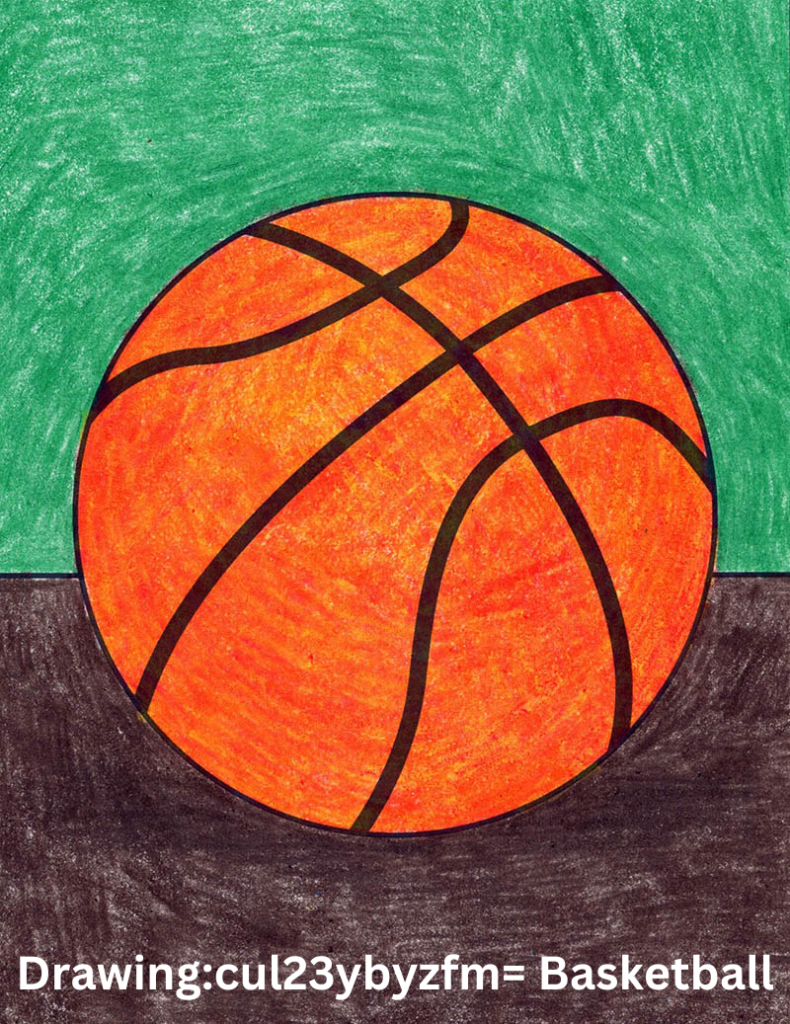Basketball, with its dynamic action and intense moments, provides a thrilling subject for artists of all skill levels. Whether capturing a high-energy game or a solitary player in motion, drawing basketball scenes demands a unique blend of understanding, technique, and observation. This guide will delve into the anatomy of drawing:cul23ybyzfm= basketball players, essential techniques for drawing the sport, and how to capture those unforgettable moments on the court.
Introduction to Drawing:cul23ybyzfm= Basketball
Drawing a basketball scene on paper allows artists to immortalize the fluid movements and dramatic intensity of the game. Through careful observation of players’ anatomy and the court’s dynamics, one can create sketches that not only depict the physical actions but also convey the emotional highs and strategic intricacies of basketball, making each drawing a vibrant narrative of the sport.
Anatomy for Drawing Basketball
Before you start sketching, it’s crucial to understand the anatomy of basketball players. Here are key aspects to consider:
- Muscle Dynamics: Basketball players are known for their athletic builds. Focus on defining muscle groups like the biceps, calves, and quadriceps, which are prominent during play.
- Posture and Proportion: Players often adopt unique stances, like crouching low or stretching high for a shot. Accurate portrayal of these postures adds realism to your drawings.
- Facial Expressions: Intense concentration, excitement, and disappointment are common expressions during a game. Capturing these can bring life to your artwork.
- Interaction of Body and Equipment: Understanding how the body interacts with the basketball and the court is vital—like the grip on the ball or the positioning of feet for a jump shot.
Techniques for Drawing:cul23ybyzfm= Basketball
When it comes to techniques, here are several to enhance your basketball drawings:
- Action Lines: Use action lines to depict movement. These lines can help suggest the direction and speed of a player or the ball.
- Perspective: Playing with perspective allows for more dynamic compositions. Try a bird’s-eye view or a court-level angle to capture the game’s intensity.
- Shading and Lighting: Proper shading can add depth and muscle definition. Consider the source of light, usually from above in indoor courts, to highlight form and features.
- Sequential Drawing: To portray movement, consider creating a sequence of drawings that show the progression of a move, like a dunk.
- Focus on Details: Small details, like the texture of the ball or sweat on the skin, can make your drawing more authentic.
- Use of Color: While black and white drawings focus on form and shadow, adding color can bring your depiction to life, especially the team colors and the wooden court.
Capture a Moment by Drawing:cul23ybyzfm= Basketball
Capturing a significant moment in basketball requires both anticipation and understanding of the game:
- Key Plays: Focus on moments like the suspense of a free throw or the climax of a slam dunk.
- Emotions and Crowds: The crowd’s reaction to a game-changing play can be as compelling as the action on the court.
- Interaction Between Players: Moments of teamwork or opposition, such as a block or an assist, are dynamic scenes to capture.
Bringing Motion to Life on Paper
Drawing basketball is not just about static images; it’s about bringing motion to life:
- Dynamic Composition: Arrange your players and elements to lead the viewer’s eye across the page, mimicking the game’s pace.
- Contrast and Conflict: Highlight the contrast between opposing teams or the internal conflict within a player during a critical moment.
- Symbolism: Use symbolic elements, like a focused beam of light on a player or shadows retreating as they make a game-winning shot, to add a deeper layer to your artwork.
Capturing the Energy: The Rhythm of Basketball
Basketball is not just a game of points but a rhythm of motions. For an artist, capturing this rhythm involves understanding the sequential flow of movements. Each dribble, pass, and jump shot carries its own rhythm, and visually representing this on paper requires acute observation. Artists can practice by watching live games or video replays, focusing on the players’ feet, hands, and ball movements. This study helps in predicting and capturing these rhythms in real-time, allowing the artist to effectively translate the dynamic nature of the game into their artwork.
The Role of Environment in Basketball Art
The setting of a basketball game is as important as the players themselves. Whether it’s an intimate street court or a sprawling professional arena, the environment sets the mood and context of your drawing. Artists should pay attention to elements like the reflective sheen of a polished court, the worn textures of an outdoor hoop, or the vibrant banners hanging in a college arena. These details do not just fill space; they enhance the realism and atmospheric depth of the scene, contributing to a more immersive and authentic portrayal.
Emotional Peaks in Court Battles
Emotions run high in basketball, from the tension of a tight game to the jubilation of a winning shot. Capturing these emotions requires a focus on facial expressions and body language. An artist must observe how emotions manifest physically—a clenched jaw, a furrowed brow, or a joyous leap into the air. These human elements connect viewers to the artwork on a deeper level, as they see echoes of their own feelings in the faces and stances of the players.
Interaction and Movement: The Essence of the Game
Interaction between players, like a defensive block or an aggressive offensive maneuver, highlights the essence of basketball. These moments are not only about physical action but also about strategic encounters. Drawing these interactions involves a deep understanding of player roles and basketball tactics. The artist must depict not just the action but also the anticipation and reaction of the other players on the court, adding a layer of narrative and tension to the artwork.
Conclusion
Drawing:cul23ybyzfm= basketball combines the thrill of sport with the challenge of artistic expression. By focusing on anatomy, technique, environment, emotion, and interaction, artists can create dynamic and engaging pieces that capture the essence of the game. Each drawing is not just a representation of action, but a story told through motion, emotion, and environment, resonating with both basketball fans and art enthusiasts alike. As artists continue to explore and depict the rich tapestry of basketball, they contribute to the enduring celebration of this beloved sport in popular culture.



